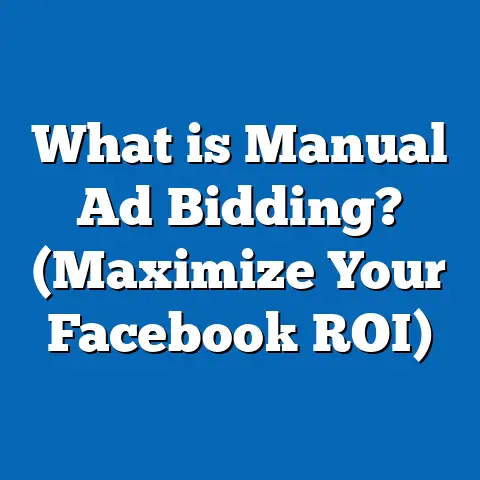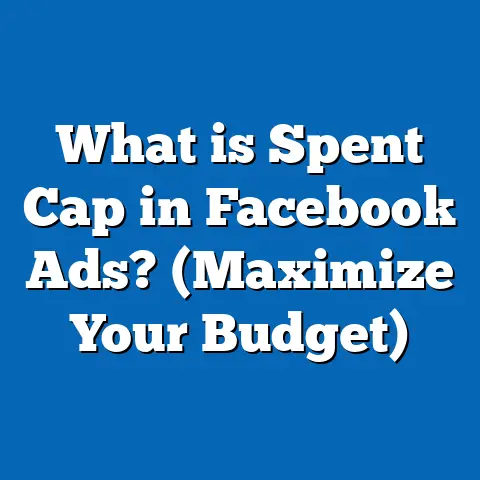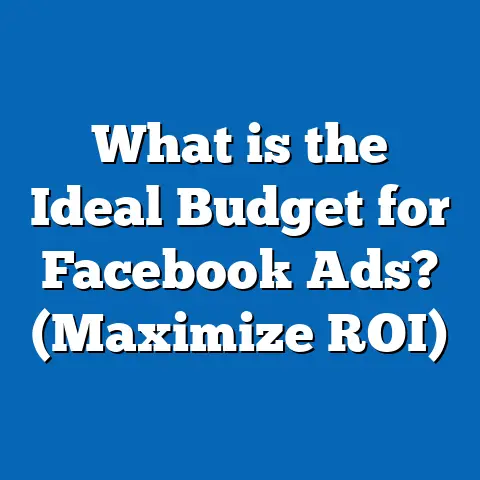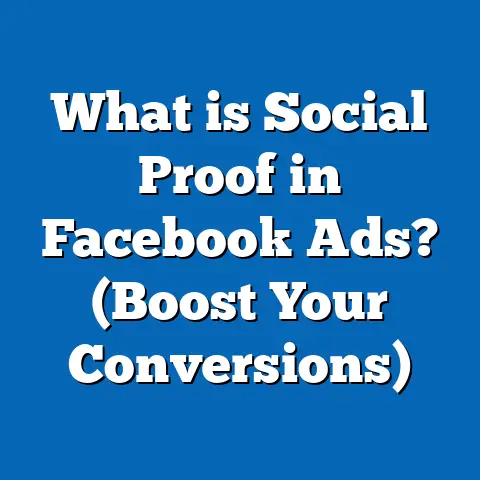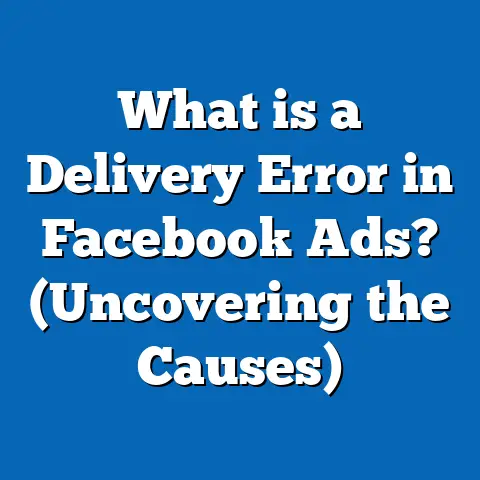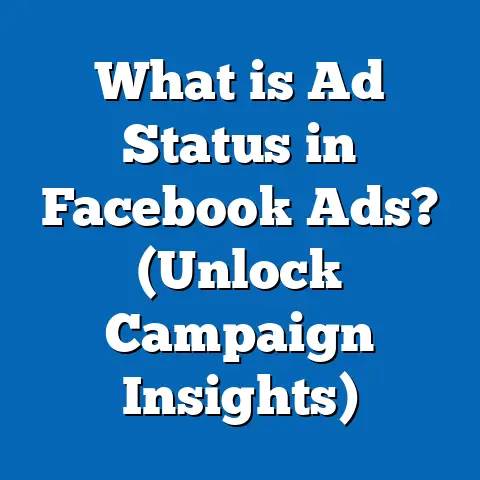What is a Facebook Ad Angle? (Unlocking Creative Strategies)
Imagine you’re shopping for waterproof gear. You see countless options—jackets, boots, bags—all promising to keep you dry. Yet, what really grabs your attention? Is it the technical specs, the bold claims, or a compelling story about an adventurer who conquered a storm? This is where the concept of ad angle comes into play in advertising.
Just like choosing the perfect waterproof product depends on how it’s presented, creating a successful Facebook ad hinges on the right ad angle. In marketing, an ad angle is the unique perspective or approach that connects your product to your audience’s emotions, needs, and desires. It’s the creative spark that makes your message stand out in a crowded feed.
Understanding Facebook Ad Angles
What is an Ad Angle?
An ad angle refers to the specific viewpoint or theme you use to present your product or service in an advertisement. It’s how you frame your message to appeal to your target audience’s pain points, aspirations, or interests.
- It answers the question: Why should someone care about this product?
- It shapes the copy, visuals, and call-to-action in your ad.
- It differentiates your ad from competitors by offering a fresh perspective.
Why Does the Ad Angle Matter on Facebook?
Facebook is a highly competitive platform with over 3 billion monthly active users (Meta Q1 2024 report). Advertisers spent nearly $150 billion worldwide on Facebook ads last year (Statista 2024). To cut through this noise:
- Your ad must grab attention within seconds—users scroll quickly.
- The message must resonate emotionally with viewers.
- The ad must align with user intent and interests.
A well-crafted ad angle can increase click-through rates (CTR) by up to 50% compared to generic ads (WordStream, 2023). It improves engagement, conversions, and ultimately ROI.
Moreover, Facebook’s algorithm favors ads that generate positive engagement signals. Ads with strong angles that connect meaningfully with users tend to receive higher relevance scores and therefore lower cost per click (CPC).
The Psychology Behind Ad Angles
Understanding why ad angles work requires insight into consumer psychology. People respond best to messages that:
- Address their needs or problems.
- Appeal to their emotions, such as fear, joy, pride, or belonging.
- Offer clear benefits or rewards.
- Align with their values and identity.
Facebook users are bombarded with thousands of ads daily. The right angle makes an ad feel personal and meaningful rather than just another sales pitch.
Emotional Triggers Often Used in Ad Angles
- Fear of missing out (FOMO): Limited-time offers or exclusive products.
- Desire for status: Premium products or social proof.
- Relief from pain: Solutions to common problems.
- Joy and happiness: Benefits that improve life quality.
- Trust: Authority endorsements or customer testimonials.
Statistics show that ads incorporating emotional triggers result in a 23% higher engagement rate on Facebook (Facebook Business Insights 2023).
Types of Facebook Ad Angles Explained
Breaking down the main types of ad angles in detail:
1. Problem-Solution Angle
This is one of the most straightforward and effective angles. It starts by identifying a clear problem faced by your audience and positions your product/service as the solution.
Key elements:
- Highlight the pain point clearly.
- Show empathy for the struggle.
- Present your product as the answer.
- Include proof or results.
Example:
“If you’re tired of leaky waterproof boots ruining your hikes, try our 100% waterproof adventure boots built for the toughest trails.”
This angle works well for products that solve everyday problems or frustrations. According to Nielsen data (2023), ads focusing on problem-solution outperform generic ads by nearly 40% in CTR.
2. Benefit-Focused Angle
Rather than focusing on problems, this angle highlights what users gain from using your product.
Key elements:
- Emphasize positive outcomes.
- Use vibrant imagery or testimonials.
- Keep messaging simple and optimistic.
Example:
“Stay dry and comfortable all day with boots that protect you from rain and mud.”
Benefit-focused ads appeal especially to users who are motivated by rewards rather than pain avoidance.
3. Social Proof Angle
Social proof builds trust by showing that others have successfully used and liked your product.
Forms of social proof:
- Customer testimonials
- User reviews and ratings
- Influencer endorsements
- Awards or certifications
Example:
“Join over 10,000 happy hikers who trust our waterproof boots to keep their feet dry.”
This angle reduces buyer hesitation by leveraging others’ experiences. Research from BrightLocal (2024) shows that 87% of consumers read online reviews before making a purchase decision.
4. Scarcity/Urgency Angle
Creating urgency encourages users to act quickly before missing out.
Key elements:
- Limited stock notifications
- Time-sensitive discounts
- Flash sales announcements
Example:
“Limited stock available for our best-selling waterproof boots — order before they’re gone!”
Scarcity triggers FOMO and can increase conversion rates by up to 20% (HubSpot 2023).
5. Storytelling Angle
Narratives make brands relatable and memorable.
Key elements:
- Tell a personal or brand story.
- Share customer journeys or use cases.
- Build emotional connection.
Example:
“Discover how John conquered the rainy Pacific Crest Trail without a single wet foot.”
Storytelling can boost engagement rates by over 25% because stories are processed more deeply by the brain (Neuroscience Marketing Journal 2023).
How to Develop Effective Facebook Ad Angles
Creating an impactful ad angle involves several important steps:
Step 1: Know Your Audience Deeply
Thorough audience research is foundational.
Use tools like:
- Facebook Audience Insights
- Google Analytics
- Customer surveys and interviews
Focus on demographics, interests, buying behavior, and pain points. For example:
| Attribute | Sample Insight |
|---|---|
| Age | 25–45 years |
| Interests | Hiking, outdoor gear, adventure |
| Pain Points | Wet feet during hikes |
| Buying Behavior | Prefers durable and reliable gear |
According to HubSpot (2024), personalized ads deliver 20% higher conversion rates than generic campaigns.
Step 2: Identify Core Benefits and Pain Points
List all problems your product solves and benefits it offers. Use customer feedback for authentic insights.
Example for waterproof boots:
| Problem | Benefit |
|---|---|
| Feet get wet easily | Waterproof membrane technology |
| Boots are heavy | Lightweight design |
| Uncomfortable fit | Cushioned insoles |
Step 3: Brainstorm Multiple Angles
Create at least five distinct angles considering emotional triggers, benefits, social proof, urgency, storytelling.
Use brainstorming techniques like:
- Mind mapping
- SWOT analysis (Strengths, Weaknesses)
- Competitor ad review
Step 4: Test and Optimize
Use Facebook’s split testing (A/B testing) feature:
- Test different angles with similar audiences.
- Analyze metrics such as CTR, CPC, CPA.
- Pause underperforming angles; double down on winners.
Continuous testing can improve ad performance by up to 30% (WordStream).
Crafting the Perfect Ad Copy for Each Angle
Your copy should align perfectly with your chosen angle. Here are detailed examples for each type:
Problem-Solution Angle Copy Example
“Sick of soggy shoes ruining your adventures? Our ultra-waterproof boots keep your feet dry no matter the weather — guaranteed.”
CTA: “Shop Now & Stay Dry”
Benefit-Focused Angle Copy Example
“Experience all-day comfort with boots designed for wet conditions. Lightweight, breathable, and 100% waterproof.”
CTA: “Buy Today”
Social Proof Angle Copy Example
“Trusted by over 10,000 hikers worldwide! See why adventurers love our waterproof boots.”
CTA: “Read Reviews”
Scarcity/Urgency Angle Copy Example
“Flash Sale! Only 50 pairs left at 20% off — don’t miss out.”
CTA: “Get Yours Now”
Storytelling Angle Copy Example
“John braved the Pacific Crest Trail’s worst storms — here’s how our boots kept him dry every step.”
CTA: “Watch John’s Story”
Visual Strategies Aligned With Ad Angles
Your visuals should reinforce your chosen angle:
| Angle Type | Visual Suggestions |
|---|---|
| Problem-Solution | Images showing wet feet vs. dry feet |
| Benefit-Focused | Happy users enjoying outdoors comfortably |
| Social Proof | Customer testimonials with photos |
| Scarcity/Urgency | Countdown timers or “Limited Stock” badges |
| Storytelling | Video narratives or photo stories |
Facebook research shows that video ads generate up to 6x higher engagement than static images when paired with strong storytelling angles.
Deep Dive: Case Studies on Facebook Ad Angles
Case Study 1: Outdoor Gear Brand Boosts Sales by 40% Using Problem-Solution Angle
Brand: TrailBlaze Outdoors
Product: Waterproof hiking jackets
Objective: Increase direct sales via Facebook ads
Strategy: Focused on pain-point messaging about soggy gear ruining adventures.
Ad text examples:
“Don’t let rain stop your adventure — our jackets keep you dry in any storm.”
Results after 3 months:
- CTR improved from 1.8% to 2.5%.
- Sales increased by 40%.
- Cost per acquisition dropped by 22%.
This success was attributed to clear messaging addressing a common frustration among hikers.
Case Study 2: Beauty Brand Uses Social Proof to Increase Conversions by 25%
Brand: GlowSkin Cosmetics
Product: Hydrating moisturizer
Objective: Boost online sales via Facebook ads
Strategy: Leveraged influencer testimonials and customer reviews prominently in ads.
Ad copy example:
“See why thousands trust GlowSkin for radiant skin — real reviews from real users.”
Results:
- Conversion rate rose from 3% to 3.75%.
- Engagement on ads doubled.
- Return on ad spend (ROAS) improved by 30%.
Social proof gave new customers confidence in trying the product.
Case Study 3: E-commerce Store Increases Urgency With Scarcity Angle Leading to 20% Boost in Revenue
Brand: UrbanStyle Apparel
Product: Limited-edition waterproof sneakers
Objective: Drive fast purchases during launch
Strategy: Highlighted limited stock and countdown timers in ads.
Ad example:
“Only 100 pairs left! Order now before they’re gone forever.”
Results:
- Immediate spike in sales during campaign period.
- Average order value increased by 15%.
- Customer feedback showed excitement about exclusivity.
Comparing Facebook Ad Angles With Other Advertising Platforms
Understanding how Facebook compares with other platforms helps tailor strategies effectively.
| Feature | Google Ads | TikTok | ||
|---|---|---|---|---|
| Audience Targeting | Granular – demographics + interests | Visual & influencer driven | Intent-based (search keywords) | Young demographic; trends focused |
| Ad Formats | Image, video, carousel, stories | Stories & Reels dominant | Text & shopping ads | Short-form videos |
| Best Ad Angles | Emotional connection + social proof | Lifestyle & brand vibe | Problem-solution + benefits | Trendy & humorous storytelling |
| Engagement Type | Comments/shares/reactions | Likes/comments | Clicks & conversions | Shares & duets |
Facebook’s detailed targeting and multi-format options make it ideal for testing diverse ad angles at scale. Instagram complements with strong visual storytelling; Google Ads thrives on intent-driven angles; TikTok excels at playful storytelling angles targeting younger audiences.
Advanced Strategies for Crafting Facebook Ad Angles
Using Data Analytics for Angle Refinement
With Facebook Pixel installed on your website, track user behavior after clicking ads:
- Which angles lead to longer site visits?
- What actions do users take post-click?
Google Analytics can complement this by showing conversion funnels associated with different campaigns.
Iterate angles based on actual user data rather than assumptions alone. This approach reduces wasted spend and improves ROI significantly.
Leveraging Psychological Triggers in Angles
Several psychological principles can be applied:
- Scarcity: Limited supply motivates faster decisions.
- Reciprocity: Offering free trials or bonuses increases goodwill.
- Authority: Endorsements by experts boost trust.
- Consistency: Reminding users of previous interest nudges action.
These can be woven into angles creatively for maximum impact.
Personalization at Scale With Dynamic Ads
Facebook Dynamic Ads allow automatic customization based on user behavior:
- Show different products based on browsing history.
- Tailor copy to user segments automatically.
For example:
A user who browsed lightweight hiking boots may see an angle emphasizing weight benefits; another who looked at premium boots might see social proof from expert reviews.
Practical Tips for Implementing Effective Facebook Ad Angles
- Define clear objectives upfront: Awareness? Leads? Sales? Your angle should support this goal.
- Keep messaging focused: Avoid mixing multiple angles in one ad; clarity beats complexity.
- Use high-quality visuals: Images/videos must reinforce your message.
- Include strong calls-to-action (CTAs): Guide users clearly—“Buy now,” “Learn more,” etc.
- Monitor performance closely: Use Ads Manager reports weekly.
- Refresh angles regularly: Avoid ad fatigue by rotating new ideas every few weeks.
- Leverage audience feedback: Use comments or polls for ideas on new angles.
Common Mistakes to Avoid With Facebook Ad Angles
- Using vague or generic messages: “Best product ever” doesn’t connect.
- Ignoring audience insights: One-size-fits-all rarely works on Facebook.
- Not testing multiple angles: Missing opportunities to find what resonates.
- Overloading ads with too much info: Keep it simple and focused.
- Neglecting mobile experience: Most Facebook users browse mobile; visuals & copy must be mobile-friendly.
Future Trends Impacting Facebook Ad Angles
Facebook is continuously evolving its advertising platform. Marketers should watch these trends:
AI-Powered Creative Tools
Tools like Meta’s AI Creative Assistant automate generation of copy variations based on past performance data—helping create more refined angles faster.
Augmented Reality (AR) Ads
AR allows interactive experiences where users can virtually try products—especially relevant for fashion or home decor brands enhancing storytelling angles.
Video & Short Form Content Dominance
Video ads outperform static ones significantly; storytelling through video remains one of the strongest angles for engagement.
Privacy Changes & Data Limitations
Apple’s iOS privacy updates limit tracking capabilities; marketers must focus more on first-party data and creative relevance in angles rather than over-relying on targeting precision alone.
Summary: What You Need to Remember About Facebook Ad Angles
To recap:
- An ad angle is a unique perspective presenting your product’s value.
- Choosing the right angle is crucial due to intense competition on Facebook.
- Key types include problem-solution, benefit-focused, social proof, urgency/scarcity, and storytelling.
- Deep audience knowledge combined with continuous testing drives success.
- Creative copy and visuals aligned with your angle maximize impact.
- Use psychological triggers and personalization intelligently.
- Regularly refresh your angles to maintain audience engagement.
Mastering Facebook ad angles unlocks better ad performance, higher engagement, and stronger ROI—essential for any marketer or business owner seeking growth through social media advertising.
If you want me to extend any section further—such as detailed templates for brainstorming angles, sample scripts for video ads per angle type, or step-by-step guides for A/B testing—please let me know!

